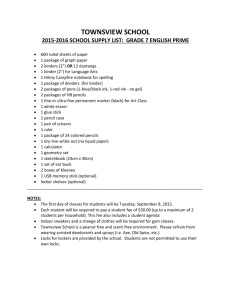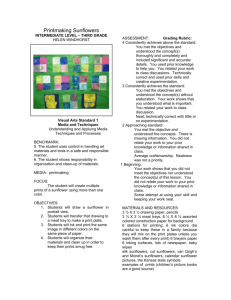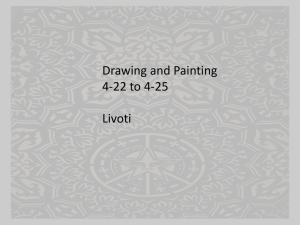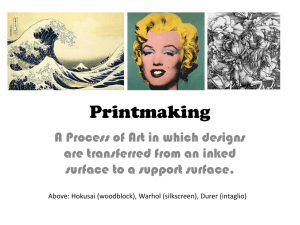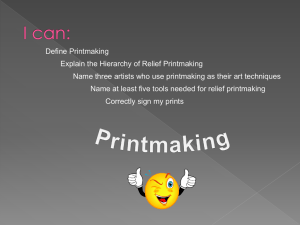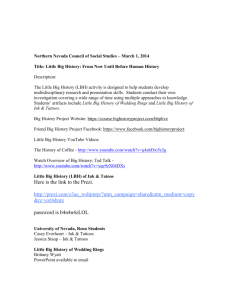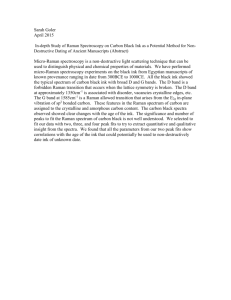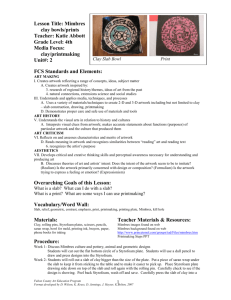Lesson for September 18, 1999: Cultural Focus
advertisement
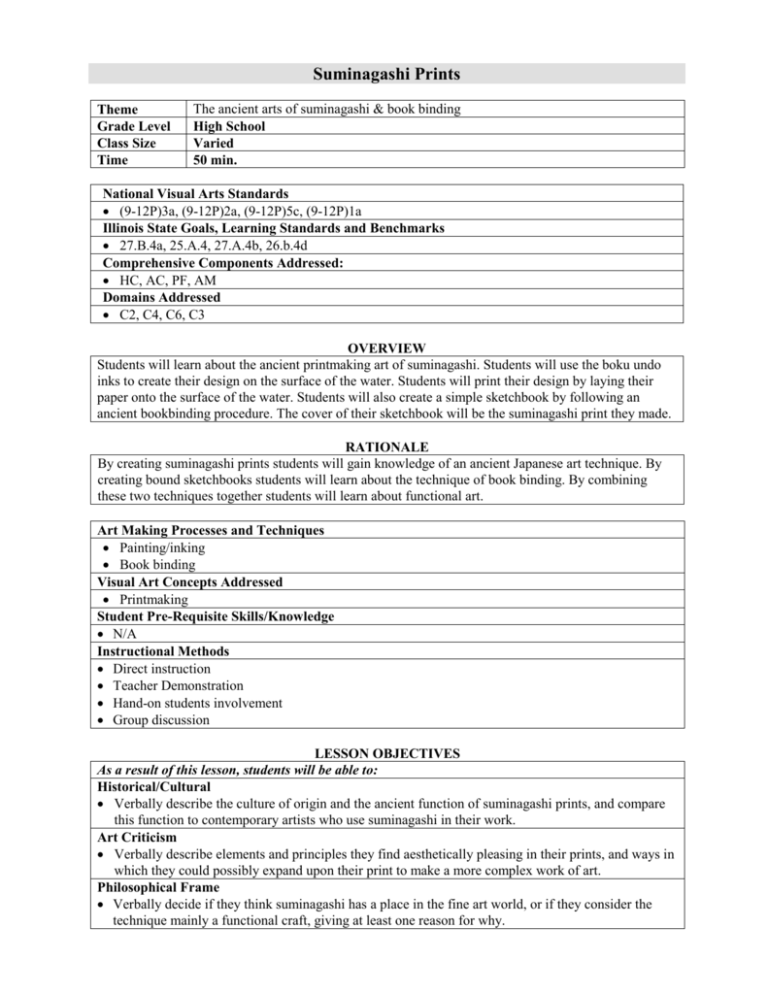
Suminagashi Prints Theme Grade Level Class Size Time The ancient arts of suminagashi & book binding High School Varied 50 min. National Visual Arts Standards (9-12P)3a, (9-12P)2a, (9-12P)5c, (9-12P)1a Illinois State Goals, Learning Standards and Benchmarks 27.B.4a, 25.A.4, 27.A.4b, 26.b.4d Comprehensive Components Addressed: HC, AC, PF, AM Domains Addressed C2, C4, C6, C3 OVERVIEW Students will learn about the ancient printmaking art of suminagashi. Students will use the boku undo inks to create their design on the surface of the water. Students will print their design by laying their paper onto the surface of the water. Students will also create a simple sketchbook by following an ancient bookbinding procedure. The cover of their sketchbook will be the suminagashi print they made. RATIONALE By creating suminagashi prints students will gain knowledge of an ancient Japanese art technique. By creating bound sketchbooks students will learn about the technique of book binding. By combining these two techniques together students will learn about functional art. Art Making Processes and Techniques Painting/inking Book binding Visual Art Concepts Addressed Printmaking Student Pre-Requisite Skills/Knowledge N/A Instructional Methods Direct instruction Teacher Demonstration Hand-on students involvement Group discussion LESSON OBJECTIVES As a result of this lesson, students will be able to: Historical/Cultural Verbally describe the culture of origin and the ancient function of suminagashi prints, and compare this function to contemporary artists who use suminagashi in their work. Art Criticism Verbally describe elements and principles they find aesthetically pleasing in their prints, and ways in which they could possibly expand upon their print to make a more complex work of art. Philosophical Frame Verbally decide if they think suminagashi has a place in the fine art world, or if they consider the technique mainly a functional craft, giving at least one reason for why. Art Making Create an 8x12 suminagashi print using at least two colors of ink that will later be the cover of their stab-bound sketchbook. Laptop Bookbinding worksheet Push Pins 4 or 5sketchbook pages (folded in half)/student Embroidery thread Sewing Needles TEACHER MATERIALS Paper towels Paper Clamps STUDENT MATERIALS Marbling ink, various colors Water tubs Absorbent paper, 2-3 per student Wooden Sticks/toothpicks Paint brushes Water cups for each ink color Water cups to wash paint bruches VOCABULARY Suminagashi Monoprint ARTISTS Andrea Peterson LESSON ACTIVITIES Set Induction Students will discuss any experiences they’ve had with printmaking Instruction Describe Suminagashi: It is a centuries-old Japanese technique for printing on water a drop at a time. Sumi means ink, and nagashi refers to moving or floating. It’s the Eastern form of paper marbling. Japanese craftsmen created patterns by floating ink on the surface of water and transferring it to a sheet of paper. Because the nature of water is ever-changing and constantly moving, Suminagashi printers are viewed as great masters of control. Each monoprint is unique like a fingerprint. Basically, you are painting by dropping ink on the surface of water, and then you print the image by transferring it from the surface of the water onto a sheet of absorbent paper. Descibe Andrea Peterson’s work: While many artists use suminagashi as mainly a decorative medium, Andrea Peterson is an artist who uses suminagashi in a conceptual way in her work. As seen in this work called “Corn Sumi” [show image] she describes it the sumi part of the piece as “dark clouds that I think are hovering over our production of corn. The sumi clouds became part of the ecosystem represented by the paper. After the sheet was dry, I did a woodblock print on top — the green — showing the actual corn.” Peterson: “Suminagashi: think of a fish in the water. You see the ink floating and moving, but in a sense it’s not in your universe. You feel that it has a plane of its own. Making suminagashi is very fluid — if the wind blows, it will ripple your design. It’s very much about the senses, about combining nature, yourself and art all in one.” Demonstrate the suminagashi process Show students how to dab a small amount of ink onto the surface of the water Build up the ink to create a marbling effect Students experiment with the ink by making a test print Each student will make their own 8x12 print using at least to colors Students will dry their prints using paper towels Time 2 min. Time 5 min. 5 min. 20 min. 15 min. Teacher will demonstrate how to bind their sketchbooks: Students will need 4 pieces of sketchbook paper to fold in half. Line up each piece of paper side-by-side in a kodex style. The suminagashi print goes on top. Students will use their push pins to poke 7 holes in the side of their paper. Students will then use their needle and thread, and follow the binding instruction sheet. Students will each need about an arm’s length of thread. Lesson Closure Time 2 min. What will you use your sketchbook for? Independent Practice/Homework If there is not enough time for students to finish their book binding they will be able to take home the binding instructions and the thread to finish at home. ACCOMODATIONS FOR SPECIFIC DIVERSE LEARNERS Adaptations and Accommodations Hands-on involvement from the teacher may be needed in multiple areas for multiple students since the techniques should be fairly new to the students. Teacher will assist in the printing process and the stab-binding process. Enrichment and Extensions Students will be encouraged to produce prints with some sort of imagery associated with them. Activity for Early Finishers Students who finish early will be able to make more than one print. OBJECTIVE-DRIVEN ASSESSMENTS Historical/Cultural Art Criticism Philosophical Frame Art Making INTERDISCIPLINARY CONNECTIONS History REFERENCES http://www.feltandwire.com/2012/01/09/andrea-peterson-gently-enlightens-us-about-suminagashi-dropby-drop/ http://cdn.dickblick.com/lessonplans/simple-suminagashi-monoprints/simple-suminagashi-monoprintsboku-undo-suminagashi.pdf * Developed and written by Nicole Buettner, Art Education, Illinois State University, 2012 *
